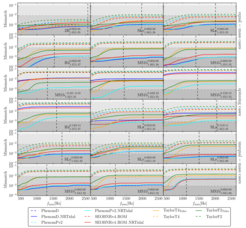Exploring the performance of inspiral-merger waveform models with tidal effects
Implementation and performance of inspiral-merger waveform models including tidal effects from numerical relativity based approximation
An international team led by AEI researchers describes how inspiral-merger waveform models with tidal effects are implemented in the LSC Algorithm Library Suite and perform detailed tests of these new waveform approximants, which are among other things very important for the analysis of BNS signals such as GW170817. The team validates the performance of these “NRTidal” models and discusses possible improvements and drawbacks of the NRTidal approximant.
Paper abstract

The combined observation of gravitational and electromagnetic waves from the coalescence of two neutron stars marks the beginning of multimessenger astronomy with gravitational waves (GWs). The development of accurate gravitational waveform models is a crucial prerequisite to extract information about the properties of the binary system that generated a detected GW signal. In binary neutron star systems (BNS), tidal effects also need to be incorporated in the modeling for an accurate waveform representation. Building on previous work, we explore the performance of inspiral-merger waveform models that are obtained by adding a numerical relativity (NR) based approximant for the tidal part of the phasing (NRTidal) to existing models for nonprecessing and precessing binary black hole systems, as implemented in the LSC Algorithm Library Suite. The resulting BNS waveforms are compared and contrasted to a set of target waveforms which we obtain by hybridizing NR waveforms (covering the last ∼10 orbits up to the merger and extending through the postmerger phase) with inspiral waveforms calculated from 30 Hz obtained with a state-of-the-art effective-one-body waveform model. While due to the construction procedure of the target waveforms, there is no error budget available over the full frequency range accessible by advanced GW detectors, the waveform set presents only an approximation of the real signal. We probe that the combination of the self-spin terms and of the NRTidal description is necessary to obtain minimal mismatches (≲0.01) and phase differences (≲1 rad) with respect to the target waveforms. We also discuss possible improvements and drawbacks of the NRTidal approximant in its current form.












